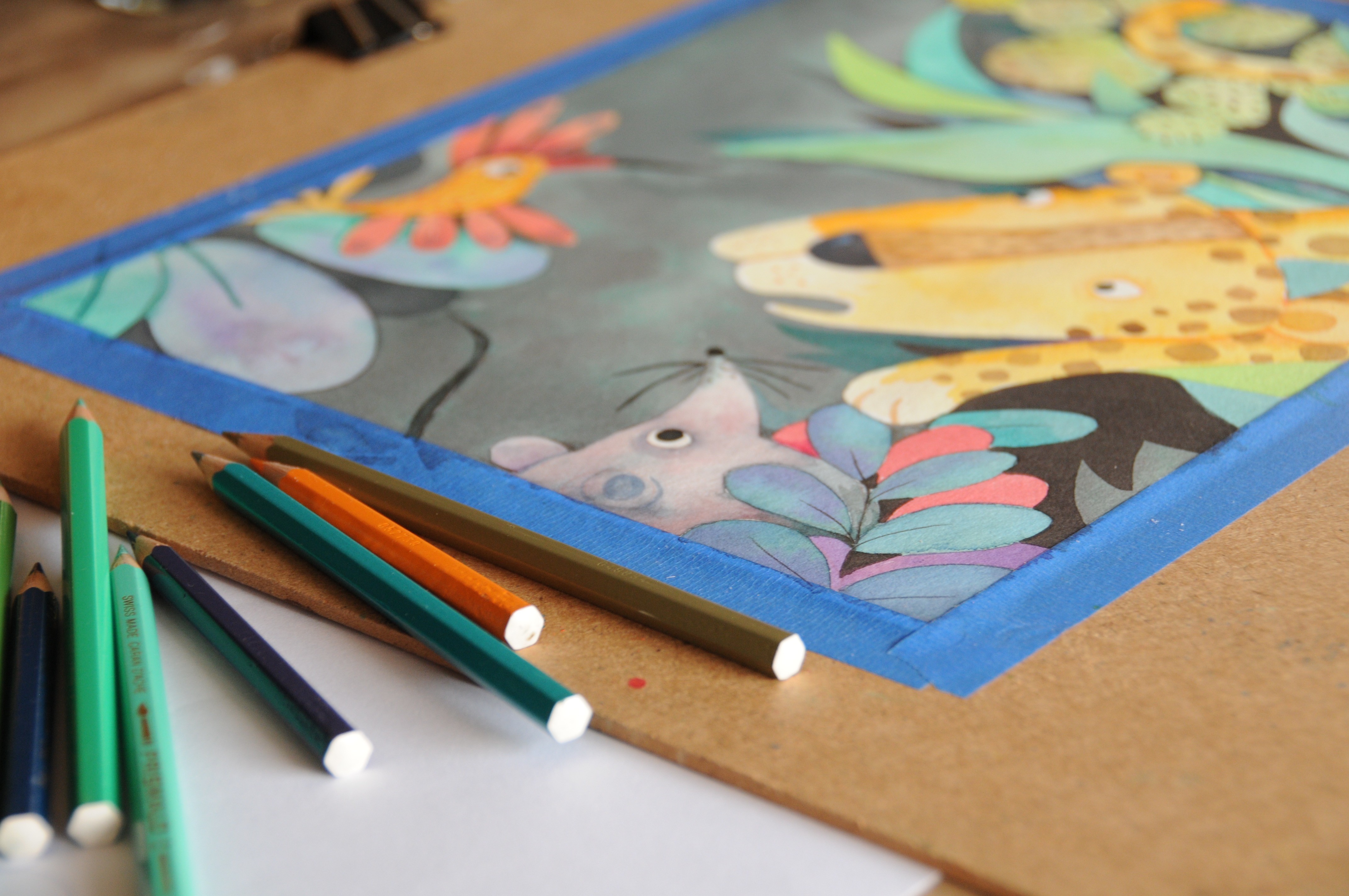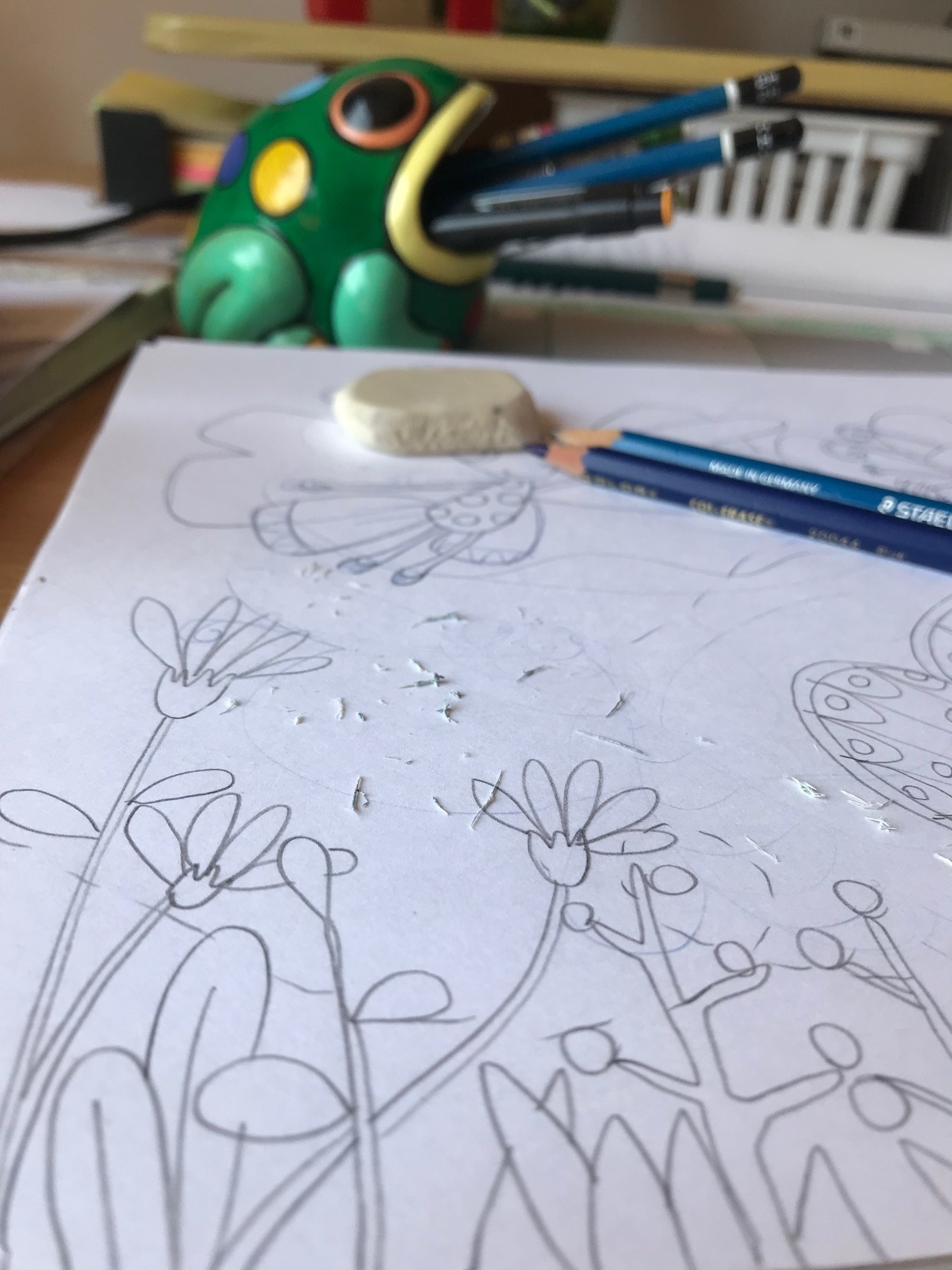
Ines Huni
Children's Illustrator
Who or what made you want to become an illustrator?
I guess I spent a lot of time drawing, as most kids do when they are young. What I do remmember vividly is having a great imagination and creativity.
Growing up, my mother was always doing artistic things in the house: ceramics, crafts and restoring furniture.
I remember in one occasion, she took me to her friend’s house and I was mesmerized by her art studio. It was then that I realized that I wanted one just like hers! The idea of having my own studio full of paint jars, brushes, colors and all kinds of tools and art materials filled me with joy. Back then, I was 10, and I never imagined I’d be an illustrator some day. I still had lots to discover and study, and there was still a long way to go!
Did you attend art school or undertake any other formal artistic training?
I studied Fine Arts in Buenos Aires (Argentina), with a specialty in drawing and engraving. At the same time, I took classes at the School of Humoristic Drawing of Garaycochea, with outstanding teachers and cartoonists from newspapers and magazines.But making comics every day was not my thing, and little by little, I began discovering children's illustration.
A few years later, when I moved to Austin (Texas), I studied animation, illustration and the use of digital programs. At the same time, I worked at Heart of Texas, an animation studio that made films for Disney and Warner Brothers (among others). There, I had the honor of drawing and learning, both at the same time.
I have taken many workshops with renowned illustrators, but I believe I am still learning - even while I teach, I learn from my students!
Who or what have been some of your major artistic influences?
All my teachers have been great influences, each one in different ways. Some taught me how to be neat when working, others the use of different techniques. Some were so strict that I learned to be self-demanding with my illustrations.
Likewise, some illustrators were very humble and willing to share their skills, for which I am eternally grateful. Thanks to them, I realised how much I love teaching and sharing what I do as well.
For several years now I’ve lived in Mexico City and consider this country a great influence for my drawings. I am amazed by their diversity in culture, landscapes, nature and mainly, their use of colors.


Which books from your own childhood really stand out?
When I was young, I loved to look at the illustrations in a book of fables that I had. I also loved The Adventures of Tom Sawyer with illustrations by Santos Martinez Koch. But my absolute favorites were the humoristic collections of Quino, an Argentine illustrator like me. His most famous character is Mafalda, an irreverent and very witty girl. Mafalda has now been translated into 27 languages. What I admire the most in these illustrations are the characters' gestures and Quino's ability to express a lot with nothing but a few strokes.
Describe your working technique and how you came to perfect it.
Usually I always work in the same way:
- I first read the story and try to get involved as much as I can by researching or documenting the subject. I put together a folder with information, photos or drawings of what I will illustrate.
- Then comes the stage of sketches. I make many, I mix them (for example the body or the position of a character and the head or clothing of another). I start the sketches with my blue animation pencil, which became almost an addiction for me. (I even think that my hand works looser when I use it!)
- I then use a traditional black pencil to do the cleaning of the sketch, leaving the essential lines and adding details.
- The next step is to make small storyboards, where I organise the composition, the space I will leave for the text and how the rhythm of the book works in its entirety.
- After having decided where everything will be layed out, I design the full page (characters, scenarios, spaces and silences).
- If I'm working with watercolors, I trace the entire illustration on high quality paper on my light tracing table.
- If I'm painting digitally, I scan the drawings to work on them on my computer using photoshop. Other times I take pictures of the sketches and use the program Procreate on my iPad Pro.


What is your favourite medium to work with and why?
I like to experiment with different techniques. I love using watercolors with touch-ups of colored pencils. Lately I'm working a lot on the iPad-pro and I love the possibility of being able to illustrate even in the waiting areas of an airport or on the table of an airplane. But I am not a very digital person, thus I seek to paint on the iPad with tools that resemble traditional techniques.



Do you keep a sketch book?
Yes, I'm a compulsive sketch book buyer, so lately I've decided not to start another one until I'm done with the one I was using. On the other hand, a few years ago, I started using a notebook that I call my mini moleskine, where I only draw women (of all ages and characteristics) in a very small space which is quite a challenge.
These illustrations begin with sketches that I then finish (some with more details, others painted in color.) Then I post them under the hashtag #myminimoleskine. I just finished my first minimoleskine and started a new one the first day of this year. I take it everywhere, especially if I'm traveling or on vacation.



How many times do you tend to draw a character until you are happy with it?
Ah, it's hard to say because some characters come up without me realizing it, it depends on how much I get involved or identify with the subject. On the other hand, there are characters that are harder to come up with and make me struggle a bit more in the decision-making process. Something that often happens to me, is that I prefer the original sketch rather than the detailed one.
Take us behind the scenes and describe your studio / workspace.
I finally have the workshop that I dreamt of at the age of 10: full of small jars with materials and colors, brushes and pencils, sketchbooks and a library of children's books ... I am also accompanied by small creatures like ceramic frogs, hummingbird alebrijes, pots with cacti, and pencil sharpeners - I even have a wooden porcupine with little pencils as thorns!
On one side of my desk there is a window with a nice view of a tree with little birdhouses and sage plants that attract many hummingbirds.
And of course, I couldn’t possibly forget my cup of coffee, good lighting and music, - all essential elements to attract creative muses.





Outline your dream project.
I have many projects and things I would like to work more on. I always say that artists have many facets of art in which we would like to venture.
For the time being, a few years ago I discovered that I love giving workshops and teaching. They started at my house but soon began expanding and going further. I want them to keep growing.
I also strive to continue having creative ideas and new projects.
What advice would you offer someone just starting out as a children’s illustrator?
I would tell them to observe, study, learn ... from everyday life, from nature, from schools, from teachers and from other colleagues ... do not stop experimenting. It isn’t wrong to copy something in order to learn, it is wrong to copy and try to make it your own.
This will all lead them to develop their own "style", something that obsesses us so much. We are the result of the places we were in, of the experiences we went through and we must always express what is important to us.
Know that each book or each assignment, will inspire different techniques or ways of working... but we remain the same illustrator even if our "style" changes.

Do you have a favourite soundtrack you listen to when you’re working?
I love almost all kinds of music, and I consider myself a very musical being. I’m always making playlists with different moods; some more modern than others, others more catchy or quieter. I really like Brazilian music too.
